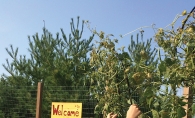You might recycle your cans and bottles or install energy-efficient LED bulbs, but have you taken extra steps to ensure that your home’s landscape is doing all it can to help the environment? Local expert Barb Letourneau from Letourneau Landscaping shares how you can help implement some environmentally friendly gardens into your own backyard.
White Bear natives Barb and Mark Letourneau have over 20 years of experience with all facets of landscaping, such as design, softscapes, and hardscapes like patios and retaining walls. Recently, they have seen an increase in interest in integrating rain gardens and edible gardens into both residential and commercial landscaping.
“We started working with the Ramsey Washington Metro Watershed District. They work with homeowners on plans for rain gardens and shoreline restoration, and they sometimes offer grant money to help pay for it,” says Barb Letourneau. According to the Watershed, these projects serve as a natural way to prevent flooding or lessen the effect of drought, protect and restore clean water by capturing pollutants in rainwater runoff, preserve and restore native plant and wildlife communities, and protect and preserve groundwater quality and quantity.
Rain Garden
Building a rain garden requires some excavating and determination of soil drainage. The soil may be augmented with gravel and sand to help filter the water. Letourneau explains that biodegradable netting is installed to help the plants establish, and a wood mulch is put on top of the soil. “Using specific native plant material is key because the root systems go down very far into the ground and that is what helps filter the water. You end up with a really beautiful, natural-looking landscape that attracts birds and butterflies,” says Letourneau. “Native plants also will handle any of the weather in our area. Even in a small garden, typically we have 75–100 plants. I like to use Northern blue flag iris, switch grass, cardinal flowers, which are red, or black-eyed Susan. They give a nice color palette, have pretty easy maintenance and work well in varied soil,” she adds. “Also for a shrub, red twig dogwood is very common for using in rain gardens.”
Edible Garden
Another trend in sustainable landscapes is adding edible gardens to existing landscaping. “People think you have to have this big garden, but you can utilize any space in your yard with enough sunshine and you can have some edible landscaping,” Letourneau says.
Varieties of lettuce, herbs, or small pepper plants can be used as ornamental annuals in flowerbeds. Rhubarb works great in the shade. “If you layer an edible border, such as lettuce, with a fall perennial, after you use the lettuce it will fill in,” she says. Also consider blueberry bushes as a nice shrub, or planting fruit trees such as apple, cherry or plum into your landscape. “There are a lot of dwarf varieties of apple trees that are easy to take care of. Most plants do need a pollinator, but there is lots of information online.”
Letourneau also encourages planting vertical gardens on patios and decks. You can build your own vertical garden with pallets and landscape fabric or purchase them online. She also says to consider using pots for vegetables, like tomatoes, among your pots of flowers.
As she puts it, “It’s really easy picking, and looks quite beautiful.”









